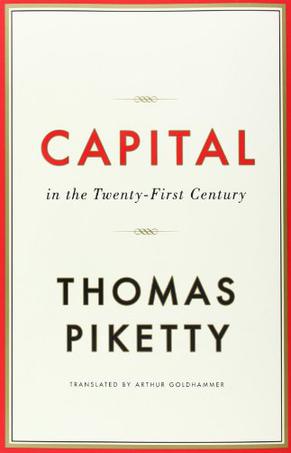Capital in the Twenty-First Century
内容简介
What are the grand dynamics that drive the accumulation and distribution of capital? Questions about the long-term evolution of inequality, the concentration of wealth, and the prospects for economic growth lie at the heart of political economy. But satisfactory answers have been hard to find for lack of adequate data and clear guiding theories. In Capital in the Twenty-First Century, Thomas Piketty analyzes a unique collection of data from twenty countries, ranging as far back as the eighteenth century, to uncover key economic and social patterns. His findings will transform debate and set the agenda for the next generation of thought about wealth and inequality.
Piketty shows that modern economic growth and the diffusion of knowledge have allowed us to avoid inequalities on the apocalyptic scale predicted by Karl Marx. But we have not modified the deep structures of capital and inequality as much as we thought in the optimistic decades following World War II. The main driver of inequality—the tendency of returns on capital to exceed the rate of economic growth—today threatens to generate extreme inequalities that stir discontent and undermine democratic values. But economic trends are not acts of God. Political action has curbed dangerous inequalities in the past, Piketty says, and may do so again.
A work of extraordinary ambition, originality, and rigor, Capital in the Twenty-First Century reorients our understanding of economic history and confronts us with sobering lessons for today.
......(更多)
作者简介
Thomas Piketty is Professor at the Paris School of Economics.
Arthur Goldhammer received the French–American Translation Prize in 1990 for his translation of A Critical Dictionary of the French Revolution.
......(更多)
目录
Acknowledgments
Introduction
I. Income and Capital
1. Income and Output
2. Growth: Illusions and Realities
II. The Dynamics of the Capital/Income Ratio
3. The Metamorphoses of Capital
4. From Old Europe to the New World
5. The Capital/Income Ratio over the Long Run
6. The Capital–Labor Split in the Twenty-First Century
III. The Structure of Inequality
7. Inequality and Concentration: Preliminary Bearings
8. Two Worlds
9. Inequality of Labor Income
10. Inequality of Capital Ownership
11. Merit and Inheritance in the Long Run
12. Global Inequality of Wealth in the Twenty-First Century
IV. Regulating Capital in the Twenty-First Century
13. A Social State for the Twenty-First Century
14. Rethinking the Progressive Income Tax
15. A Global Tax on Capital
16. The Question of the Public Debt
Conclusion
Notes
Contents in Detail
List of Tables and Illustrations*
Index
* Tables and Illustrations
Tables
Table 1.1. Distribution of world GDP, 2012
Table 2.1. World growth since the Industrial Revolution
Table 2.2. The law of cumulated growth
Table 2.3. Demographic growth since the Industrial Revolution
Table 2.4. Employment by sector in France and the United States, 1800–2012
Table 2.5. Per capita output growth since the Industrial Revolution
Table 3.1. Public wealth and private wealth in France in 2012
Table 5.1. Growth rates and saving rates in rich countries, 1970–2010
Table 5.2. Private saving in rich countries, 1970–2010
Table 5.3. Gross and net saving in rich countries, 1970–2010
Table 5.4. Private and public saving in rich countries, 1970–2010
Table 7.1. Inequality of labor income across time and space
Table 7.2. Inequality of capital ownership across time and space
Table 7.3. Inequality of total income (labor and capital) across time and space
Table 10.1. The composition of Parisian portfolios, 1872–1912
Table 11.1. The age–wealth profile in France, 1820–2010
Table 12.1. The growth rate of top global wealth, 1987–2013
Table 12.2. The return on the capital endowments of US universities, 1980–2010
Illustrations
Figure I.1. Income inequality in the United States, 1910–2010
Figure I.2. The capital/income ratio in Europe, 1870–2010
Figure 1.1. The distribution of world output, 1700–2012
Figure 1.2. The distribution of world population, 1700–2012
Figure 1.3. Global inequality 1700–2012: divergence then convergence?
Figure 1.4. Exchange rate and purchasing power parity: euro/dollar
Figure 1.5. Exchange rate and purchasing power parity: euro/yuan
Figure 2.1. The growth of world population, 1700–2012
Figure 2.2. The growth rate of world population from Antiquity to 2100
Figure 2.3. The growth rate of per capita output since the Industrial Revolution
Figure 2.4. The growth rate of world per capita output from Antiquity to 2100
Figure 2.5. The growth rate of world output from Antiquity to 2100
Figure 2.6. Inflation since the Industrial Revolution
Figure 3.1. Capital in Britain, 1700–2010
Figure 3.2. Capital in France, 1700–2010
Figure 3.3. Public wealth in Britain, 1700–2010
Figure 3.4. Public wealth in France, 1700–2010
Figure 3.5. Private and public capital in Britain, 1700–2010
Figure 3.6. Private and public capital in France, 1700–2010
Figure 4.1. Capital in Germany, 1870–2010
Figure 4.2. Public wealth in Germany, 1870–2010
Figure 4.3. Private and public capital in Germany, 1870–2010
Figure 4.4. Private and public capital in Europe, 1870–2010
Figure 4.5. National capital in Europe, 1870–2010
Figure 4.6. Capital in the United States, 1770–2010
Figure 4.7. Public wealth in the United States, 1770–2010
Figure 4.8. Private and public capital in the United States, 1770–2010
Figure 4.9. Capital in Canada, 1860–2010
Figure 4.10. Capital and slavery in the United States
Figure 4.11. Capital around 1770–1810: Old and New World
Figure 5.1. Private and public capital: Europe and the United States, 1870–2010
Figure 5.2. National capital in Europe and America, 1870–2010
Figure 5.3. Private capital in rich countries, 1970–2010
Figure 5.4. Private capital measured in years of disposable income
Figure 5.5. Private and public capital in rich countries, 1970–2010
Figure 5.6. Market value and book value of corporations
Figure 5.7. National capital in rich countries, 1970–2010
Figure 5.8. The world capital/income ratio, 1870–2100
Figure 6.1. The capital–labor split in Britain, 1770–2010
Figure 6.2. The capital–labor split in France, 1820–2010
Figure 6.3. The pure return on capital in Britain, 1770–2010
Figure 6.4. The pure rate of return on capital in France, 1820–2010
Figure 6.5. The capital share in rich countries, 1975–2010
Figure 6.6. The profit share in the value added of corporations in France, 1900–2010
Figure 6.7. The share of housing rent in national income in France, 1900–2010
Figure 6.8. The capital share in national income in France, 1900–2010
Figure 8.1. Income inequality in France, 1910–2010
Figure 8.2. The fall of rentiers in France, 1910–2010
Figure 8.3. The composition of top incomes in France in 1932
Figure 8.4. The composition of top incomes in France in 2005
Figure 8.5. Income inequality in the United States, 1910–2010
Figure 8.6. Decomposition of the top decile, United States, 1910–2010
Figure 8.7. High incomes and high wages in the United States, 1910–2010
Figure 8.8. The transformation of the top 1 percent in the United States
Figure 8.9. The composition of top incomes in the United States in 1929
Figure 8.10. The composition of top incomes in the United States, 2007
Figure 9.1. Minimum wage in France and the United States, 1950–2013
Figure 9.2. Income inequality in Anglo-Saxon countries, 1910–2010
Figure 9.3. Income inequality in Continental Europe and Japan, 1910–2010
Figure 9.4. Income inequality in Northern and Southern Europe, 1910–2010
Figure 9.5. The top decile income share in Anglo-Saxon countries, 1910–2010
Figure 9.6. The top decile income share in Continental Europe and Japan, 1910–2010
Figure 9.7. The top decile income share in Europe and the United States, 1900–2010
Figure 9.8. Income inequality in Europe versus the United States, 1900–2010
Figure 9.9. Income inequality in emerging countries, 1910–2010
Figure 10.1. Wealth inequality in France, 1810–2010
Figure 10.2. Wealth inequality in Paris versus France, 1810–2010
Figure 10.3. Wealth inequality in Britain, 1810–2010
Figure 10.4. Wealth inequality in Sweden, 1810–2010
Figure 10.5. Wealth inequality in the United States, 1810–2010
Figure 10.6. Wealth inequality in Europe versus the United States, 1810–2010
Figure 10.7. Return to capital and growth: France, 1820–1913
Figure 10.8. Capital share and saving rate: France, 1820–1913
Figure 10.9. Rate of return versus growth rate at the world level, from Antiquity until 2100
Figure 10.10. After tax rate of return versus growth rate at the world level, from Antiquity until 2100
Figure 10.11. After tax rate of return versus growth rate at the world level, from Antiquity until 2200
Figure 11.1. The annual inheritance flow as a fraction of national income, France, 1820–2010
Figure 11.2. The mortality rate in France, 1820–2100
Figure 11.3. Average age of decedents and inheritors, France, 1820–2100
Figure 11.4. Inheritance flow versus mortality rate, France, 1820–2010
Figure 11.5. The ratio between average wealth at death and average wealth of the living, France, 1820–2010
Figure 11.6. Observed and simulated inheritance flow, France, 1820–2100
Figure 11.7. The share of inherited wealth in total wealth, France, 1850–2100
Figure 11.8. The annual inheritance flow as a fraction of household disposable income, France, 1820–2010
Figure 11.9. The share of inheritance in the total resources (inheritance and work) of cohorts born in 1790–2030
Figure 11.10. The dilemma of Rastignac for cohorts born in 1790–2030
Figure 11.11. Which fraction of a cohort receives in inheritance the equivalent of a lifetime labor income?
Figure 11.12. The inheritance flow in Europe, 1900–2010
Figure 12.1. The world’s billionaires according to Forbes, 1987–2013
Figure 12.2. Billionaires as a fraction of global population and wealth, 1987–2013
Figure 12.3. The share of top wealth fractiles in world wealth, 1987–2013
Figure 12.4. The world capital/income ratio, 1870–2100
Figure 12.5. The distribution of world capital, 1870–2100
Figure 12.6. The net foreign asset position of rich countries
Figure 13.1. Tax revenues in rich countries, 1870–2010
Figure 14.1. Top income tax rates, 1900–2013
Figure 14.2. Top inheritance tax rates, 1900–2013
......(更多)
读书文摘
税收不是一个技术问题。它很大程度上是一个政治哲学问题,(...)没有税收,社会就没有共同命运,集体行动也就无从谈起,这是常理。
许多人认为,现代增长天然地重劳动轻遗产,重能力轻出身。这个普遍想法的来源是什么?我们有多大把握确定它是正确的呢?
......(更多)






